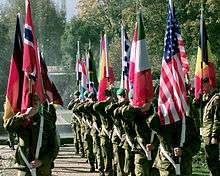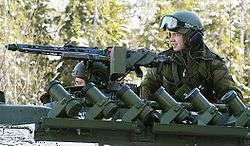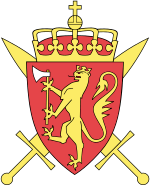Structure of the Norwegian Army

The Structure of the Norwegian Army has seen considerable change over the years. In 2009 the Army introduced the new command and control lines. The General Inspector now commands three subordinate major commands and 5 smaller support units:[1][2]
- Brigade Nord in Bardufoss
- Garnisonen i Sør-Varanger in Høybuktmoen
- Hans Majestet Kongens Garde - HM the Kings Guard in Oslo
- Hærstaben - Army Staff in Bardufoss
- Operasjonsstøtteavdelingen for Hæren - Army Operations Support Group in Bardufoss (Maintenance, Catering, etc.)
- Krigsskolen - Military Academy in Oslo
- Hærens befalsskole - Army Command School in Rena
- Hærens våpenskole - Army Weapons School in Rena
- Kampeskadronen - OPFORCE Training Squadron
- Forsvarets kompetansesenter for logistikk og operativ støtte – Armed Forces Logistic and Operational Support Competence Center in Sessvollmoen
- Armed Forces Military Dogs School
- Armed Forces Transport School
- Armed Forces Logistic School
- Armed Forces Ammunition and EOD School
- Armed Forces Military Police School
The Brigade Nord commands all the operational units of the Army, with the exception of His Majesty the Kings Guard and the border patrol unit stationed in Sør-Varanger. As the army has no air defence capabilities anymore it relies on the NASAMS missile units of the Royal Norwegian Air Force for air defence. The Army Special Forces Command (Norwegian: Forsvarets Spesialkommando/Hærens Jegerkommando, abbreviated to FSK/HJK) is the armed forces' ranger-/parachute and special forces unit. The FSK/HJK has the ability to execute operations in the North Sea to defend Norway's oil installations. Internationally, the FSK/HJK has undertaken in recent years out-of-area missions, most recently two missions in Afghanistan.[3]
The standing army is primarily formed around four main combat units. One of these, Hans Majestet Kongens Garde, which is also the foot guards unit of the Norwegian Army, is a light role infantry battalion dedicated to the urban warfare role. The remaining three are all classed as mechanised infantry units, but are in reality fully formed all arms battlegroups, with integrated armour and artillery units alongside the mechanised infantry. Of these, Telemarkbataljon is made up entirely of professional soldiers, while Panserbataljonen and Bataljon 2 are formed with a mixture of professional soldiers and conscripts.




Military units
Brigade Nord
| Name | Headquarters | Type |
|---|---|---|
| Panserbataljonen | Setermoen | All Arms Battlegroup |
| Telemark Bataljon | Rena | All Arms Battlegroup |
| 2. Bataljon | Skjold | All Arms Battlegroup |
| Artilleribataljonen | Setermoen | Self-propelled Artillery Battalion |
| Ingeniørbataljonen | Skjold | Combat Engineer Battalion |
| Etterretningsbataljonen | Setermoen | Military Intelligence & Electronic Warfare Battalion |
| Sambandsbataljonen | Bardufoss | Signal Battalion |
| Sanitetsbataljonen | Setermoen | Medical Battalion |
| CSS-bataljonen | Bardufoss | Combat Service Support Battalion |
| Jegerkompaniet | Lakselv | Rangers / Long Range Surveillance Company |
| MP-kompaniet | Bardufoss | Military Police Company |
Other Units
| Name | Headquarters | Type |
|---|---|---|
| Hans Majestet Kongens Garde | Huseby Leir | Light Infantry/Urban Warfare |
| Garnisonen i Sør-Varanger | Høybuktmoen | Long Range Reconnaissance Patrol / Border Guard |
References
- ↑ http://www.mil.no/multimedia/archive/00136/0560_H_rbrosjyren_N_136081a.pdf%5Bpermanent+dead+link%5D
- ↑ "Archived copy". Archived from the original on 2010-09-03. Retrieved 2015-11-27.
- ↑ "Hærens jegerkommando/Forsvarets spesialkommando". Forsvaret (in Norwegian). Archived from the original on August 2, 2008. Retrieved 15 February 2009.
